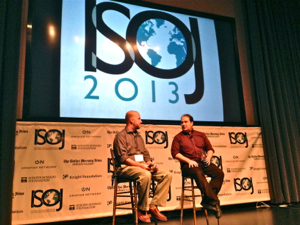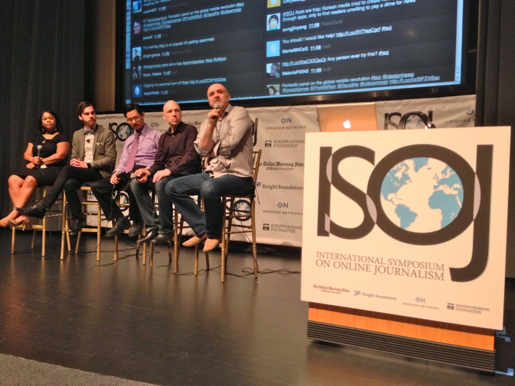Traditional news organizations need to embrace the disruption brought by digital culture — or they risk becoming obsolete.
That was the message late last week at the International Symposium on Online Journalism hosted by the Knight Center for Journalism in the Americas at the University of Texas at Austin, where about 370 of the world’s journalists, researchers and media watchers grappled with the hard questions for a beleaguered traditional media industry that is now more than a decade into its disruptive transformation.
The problem is many media companies view digital technologies through a lens of traditional journalism and thus, fail to strategize properly, said Clark Gilbert, president and CEO of Deseret News Publishing Company.
“In a post-disruption world, why would people pick up a paper at all? Why would someone turn on the 10 o’clock newscast?” Gilbert asked. “If you are not asking those fundamental questions, there is not a future for you legacy organization.”
The key to surviving? Innovate. Fail. Innovate again.

“The possibilities are endless for the ways that we can bring stories to our audiences today,” said Jill Abramson, the New York Times executive editor and an ISOJ keynote speaker.
Digital Disruption
Prior disruptive situations for the press entailed the telegraph, radio and television, which fundamentally changed the profession. In his talk, Gilbert characterized digital technologies as an external challenger. Interactivity diffuses the press’ information authority, helping to create a Post Industrial Journalism, as suggested in a white paper published by the Tow Center for Digital Journalism at Columbia University.
“The industrial age of news is coming to a close,” said Tow Center Director Emily Bell. “We can’t even describe this as an industry any more. There is no longer something that can broadly be described as the press. There is no longer something that can broadly be described as the public. Our ecosystem is much much more fragmented than that.”

In the lifecycle of disruption, an established business eventually loses the ability to grow because of the competition from the disruptor entity, Gilbert said.
“Despite the incredible changes we’ve seen in media, we still treat the news as a one-way street,” said keynote speaker Andy Carvin, the senior strategist on the social-media desk at NPR. “We need to rethink what it means to inform the public.”
(You can read the entire transcript of Carvin’s speech here.)
The good news, Gilbert added, is that a path to survival exists.
Path to Survival
That path depends upon the company focusing on what it is good at, repositioning for that niche and getting costs in line with the post-disruption world.
David Skok, the director of digital at Global News in Canada, said journalists at his company must conceptualize every story as ongoing, every beat as a site and every author as a brand.
Jim Brady, editor-in-chief of Digital First Media, urged news organizations to avoid duplication of efforts within the company. Use any freed-up resources to do more in-depth data work or content curation.
Chris Courtney, mobile product manager for the Tribune Company, always asks “what problem can this solve?” rather than “what feature does this bring?”
Jim Moroney, publisher and CEO of The Dallas Morning News, argued that news organizations must find alternative revenue streams outside journalism. Last year the Dallas Morning News bought or started five companies to complement the news brand; in the first quarter of 2013 revenues from these startups helped offset print ad revenue losses.
“You can have the integrated business model on one side, and that can be the brand,” said Skok. “But then you can have the disruptive businesses on the other side, and those can have unique brands as well. It is not an either/or.”
Does your site design respond to the time, location and customized information for each user? asked Travis Swicegood, director of technology for Texas Tribune.
Responsive Design and Rich Storytelling
There was a session during the first day of ISOJ about responsive design.
“We need to be responsive not in a technical sense but a personal sense,” Swicegood said. “How do I respond to this particular user?”
Take advantage of digital tools as a way to revolutionize journalism but stay true to storytelling. Abramson pointed to Snow Fall, the Pulitzer-Prize winning feature package as a “new organic way of reading” that helped people experience an avalanche alongside the skiers in the story.
“There are certain stories that I think are made for this kind of rich narrative multimedia storytelling,” she said. “In general those are ones that have intense characters, that have a narrative spine where something unfolds and that lend itself to the particular technology that you are using.”
The problem? It was “an expensive project with layers of reporters with different talents on it.”
So, “always have a plan B,” said Chris Courtney, mobile product manager of the Tribune Company. Oh, and “fail as fast as possible.”
J-Schools Can Help
Academics reported study results about how to navigate this disruption such as redefining the metrics on “engagement,” which often still comprise site bookmarks, return visits, and time spent on site.
“None of these numbers are improving,” said Jonathan Groves, an assistant professor at Drury University. “They are thinking in terms of loyalty; they are not thinking about deep engaged behaviors.”
Specific journalistic strategies for effective engagement from the ISOJ studies included:
- Targeting key influencers,
- Asking questions alongside linked information,
- Participating in comments sections,
- Acknowledging citizen content, and
- Thinking of “engagement” as transactional rather than as quantifiable.
“We need to get to the stage where people are so engaged with your brand that they are brand ambassadors,” Groves said.
This new skillset begins with journalism schools, whose tasks include:
- Teach specialized knowledge, data analysis, statistical literacy, programming as well as how to collaborate, be transparent and tell better stories faster, said Bell.
- Teach graphics literacy along with media literacy, said Alberto Cairo, lecturer at the University of Miami.
- Teach journalists to confront rumors on social media, challenge citizen contributors on sourcing and accuracy, and engage as an individual (not as a media entity), added Carvin.

“By engagement I mean, why don’t we use these incredibly powerful tools to talk with them, listen to them and help us all understand the world a little better?” Carvin said. “We now report in a networked world. We can no longer afford to underplay the public’s role in propagating information.”
Participants exuded optimism about the potential for digital tools to improve journalism and provide a basis for business models while figuring out the privacy, ethics, scalability and fear of failure that come with this emergent world.
“The future of journalism belongs to those people who believe in the future,” Tom Rosenstiel, executive director for the American Press Institute, said.
And from Joshua Benton of Harvard’s NiemanLab: “Let’s all go make unicorns.”
After a dozen years as a reporter, Sue Robinson went back to school to get her PhD from Temple University, graduating in 2007. She is now an associate professor teaching and researching new technologies, social media, information authority and journalism at the University of Wisconsin-Madison’s School of Journalism & Mass Communication. She can be found @suerobinsonUW on Twitter or via email at [email protected].

